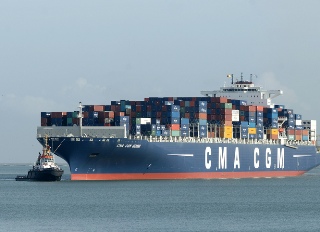 If approved, the planned alliance between CMA CGM, China Shipping Container Lines (CSCL), and United Arab Shipping Company (UASC) will put the East-West routes completely in the hands of alliances, locking out independents from the trades, according to Drewry’s latest analysis.
If approved, the planned alliance between CMA CGM, China Shipping Container Lines (CSCL), and United Arab Shipping Company (UASC) will put the East-West routes completely in the hands of alliances, locking out independents from the trades, according to Drewry’s latest analysis.
The Ocean Three “can be seen as the last piece in the alliance jigsaw for the foreseeable future,” it said. “This is not to say that there will be only four competitors left on these routes; each carrier will continue to compete against all other carriers inside and outside of its alliance.”
Last week, CMA CGM, CSCL, and UASC announced the formation of the “Ocean Three” alliance, a combination of vessel sharing, slot exchange and slot charter agreements that was long foreseen in the industry after Maersk Line and Mediterranean Shipping Co. (MSC) decided in June to jettison CMA CGM from their 10-year “2M” vessel-sharing agreement that replaced the original P3 Network plan.
The Ocean Three agreement will cover the key East-West container trades from Asia to and from North Europe, the Mediterranean, and both coasts of North America, effective end-2014 or early next year.
It will initially operate 15 weekly services using a total of 138 container ships, with the possibility of extending the agreement to cover the trans-Atlantic trade, “which if fruitful would mark new entry into the lane for both CSCL and UASC.”
Moreover, each carrier will continue to offer services outside of the agreement under existing service agreements with other carriers.
The coming service revamp
Drewry’s analysis tracks the possible changes in the three carriers’ existing service structures with the linkup. It sees little change in the Asia-North Europe trade “other than general vessel upgrades so that all four services will be tonnaged at a minimum of 14,000 TEU average.”
For Asia-Mediterranean, the number of weekly services will come down to four from five, but the average capacity of the remaining loops is expected to increase with the Black Sea service being upgraded from 6,500-7,000 TEUs to 9,400 TEUs.
In the trans-Pacific, the main changes will occur on the Asia-U.S. East Coast lane, with greater focus on the Suez routing to allow bigger ships.
Ocean Three is subject to regulatory approval, but it should have no problem as its current market share is less than 30 percent on all routes. Drewry says Ocean Three will have its largest share on the Asia-Mediterranean trade route with a 27 percent share of all effective westbound vessel capacity.
“The trend towards these so-called ‘mega-alliances’ is a defensive response to the prolonged down cycle for industry profits, as carriers have realized there is safety in numbers,” Drewry said. “With little prospect for M&A among the major players, alliances are the half-way house towards consolidation that many in the industry believe is necessary to secure future profitability.”
But the underlying motivation of the Ocean Three, as with all of the other mega-alliances “is the quest for economies of scale and to reduce slot costs,” said Drewry. Based on the existing fleet of ultra-large container vessels (ULCVs) of 10,000 TEUs and above, the Ocean Three carriers currently rank second behind the 2M lines.
Ocean Three’s orderbook for ULCVs is not as large as that of the five members of the CKYHE Alliance, but is of sufficient magnitude that when all said vessels are delivered, the average size of its biggest ships will be around 13,200 TEUs, second only to the 2M’s average of 14,800 TEUs.
Customer service and reliability
As for customer service and reliability that the new agreement would provide, the Ocean Three carriers have an advantage over the 2M carriers as Maersk and MSC have vastly different track records on ship reliability.
The Ocean Three carriers have been broadly on a par for ship reliability based on Drewry’s research since the first quarter of 2012, with each carrier’s on-time average close to 69 percent over the course of the 10 quarters.
In contrast, Maersk averages about 84 percent on-time, while MSC lags well behind on just 57 percent, indicating the 2M partners have much work to do to align their operations.
In Drewry’s view, Ocean Three will have “an extensive East-West network (although not quite as wide as 2M’s), a large share of the East-West markets, superior access to big-ship costs advantages, and no apparent incompatibility between the schedule reliability objectives of its members.”
But it added that the success of each alliance will depend on how these often disparate companies in ownership structure, nationality, and culture can operate together. “On the basis of the fewer the chiefs the better, 2M would appear best placed of the alliances, with Ocean Three not far behind.”
Photo: bathyporeia




